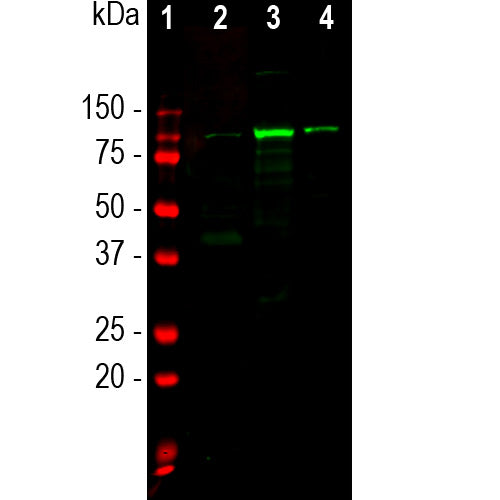

EnCor Biotechnology
Rabbit Polyclonal Antibody to Aldehyde Dehydrogenase 1 Family Member L1 (ALDH1L1), Cat# RPCA-ALDH1L1
Description
The RPCA-ALDH1L1 was made against a recombinant construct expressing the first 400 amino acids of human ALDH1L1 and is known to work on human, rat and mouse cells and tissue extracts. It stains the expected 100kDa band on western blots of crude tissue extracts cleanly and we document that it also works well not only for IF and ICC but also on formalin fixed paraffin embedded sections, select the "Additional Data" for this data. It can be used to identify astrocytes in cell culture and sectioned material. EnCor used the same immunogen to generate a high quality mouse monoclonal antibodies to ALDH1L1, MCA-4A12.
- Cell Type Marker
- Cytoplasmic Enzyme
- Developmental Marker
- Immunohistochemistry Verified
- Rabbit Polyclonal Antibodies
Add a short description for this tabbed section
| Immunogen: | Recombinant construct of amino acids 1-400 of human protein expressed in and purified from E. coli |
| HGNC Name: | ALDH1L1 |
| UniProt: | O75891 |
| Molecular Weight: | 100kDa |
| Host: | Rabbit |
| Species Cross-Reactivity: | Human, rat, mouse |
| RRID: | AB_2572222 |
| Format: | Serum plus 5mM NaN3 |
| Applications: | WB, IF/ICC, IHC |
| Recommended Dilutions: | WB: 1:2,000-5,000. IF/IHC: 1:500-1:1,000. |
| Storage: | Store at 4°C for short term, for longer term at -20°C. Avoid freeze/thaw cycles. Stable for 12 months from date of receipt. |
Aldehyde dehydrogenase family 1, member L1 (ALDH1L1) is a cytosolic enzyme and one member of a large family of aldehyde dehydrogenases. ALDH1L1 catalyses the NADP(+) dependent oxidation of 10-formyltetrahydrofolate to tetrahydrofolate and Carbon dioxide (1). ALDH1L1 expression is highly tissue specific, with very high levels in the liver, representing up to 1% of the total pool of soluble cell proteins. Cahoy et al. used fluorescent activated cell sorting to isolate astrocytes from enhanced green fluorescent protein (GFP) expressing transgenic mice, with GFP expression being under the control of the S100β promoter, expected to direct GFP to astrocytes. They then created a transcriptome database of the gene expression levels using Affymetrix GeneChip arrays (2). They identified ALDH1L1 mRNA as very abundant and expressed only in astrocytes, suggesting that ALDH1L1 protein would be a expressed at high levels and only in astrocytes. Based on immunocytochemical studies they claimed that ALDH1L1 is more widely expressed in astrocytes throughout the brain, while the widely used astrocyte marker GFAP shows more predominant expression in white matter. The also claimed that AlDH1L1 expression gives a more detailed view of astrocyte morphology since it is expressed throughout the cell including fine protoplasmic protrusions. In contrast GFAP is found in the intermediate filament core of the astrocyte, and these filaments are not found in finer cytoplasmic protrusions. Loss of function or expression of ALDH1L1 is associated with decreased apoptosis, increased cell motility, and cancer progression, suggesting its role as a potential biomarker and a target in cancer therapy (3-5).

Chromogenic immunostaining of a NBF fixed paraffin embedded human brain cortex section with rabbit pAb to ALDH1L1, RPCA-ALDH1L1, dilution 1:500, detected with DAB (brown) following the Vector Labs ImmPRESS method and reagents with citrate buffer retrieval. Hematoxylin (blue) was used as the counterstain. The RPCA-ALDH1L1 antibody specifically labels the cytoplasm of astrocytic glial cells. This antibody performs well in testing with 4% PFA and standard NBF fixed mouse, rat and human tissue. Mouse select image for larger view.
1. Kisliuk RL. Folate biochemistry in relation to antifolate selectivity. In :Jackman AL, editor. Antifolate drugs in cancer therapy. Totowa, NJ: Humana Press; p. 13-36 (1999).
2. Cahoy JD, et al. A transcriptome database for astrocytes, neurons, and oligodendrocytes: a new resource for understanding brain development and function. J. Neurosci. 28:264-78 (2008).
3. Krupenko SA, Oleinik NV. 10-formyltetrahydrofolate dehydrogenase, one of the major folate enzymes, is down-regulated in tumor tissues and possesses suppressor effects on cancer cells. Cell Growth Differ. 13:227-36 (2002).
4. Rodriguez FJ, et al. Gene expression profiling of NF-1-associated and sporadic pilocytic astrocytoma identifies aldehyde dehydrogenase 1 family member L1 (ALDH1L1) as an underexpressed candidate biomarker in aggressive subtypes. J. Neuropath. Exp. Neurol. 67:1194-204 (2008).
5. Oleinik NV, Krupenko NI, Krupenko SA. Epigenetic Silencing of ALDH1L1, a Metabolic Regulator of Cellular Proliferation, in Cancers. Genes Cancer. 2:130-9 (2011).
Add a short description for this tabbed section





